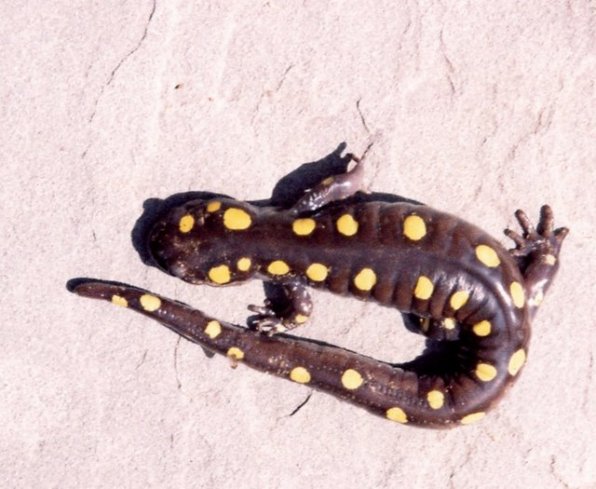One spring day while clearing out some leaf litter, my family had a rare encounter with a prowler of the night – a 6-inch-long spotted salamander. These secretive creatures hide underground in burrows and in rotting logs during the day, and they do their hunting of worms and insects at night. They are glistening jet black with bright yellow spots and are the moles of the salamander family.
They also have a secret defense: When a predator grabs a spotted salamander in its mouth, the salamander excretes a toxic, nasty-tasting liquid from poison glands in its skin. What appeared to be an easy gourmet snack becomes a never-to-be-forgotten nightmarish experience. The next time that predator spots a spotted salamander, those spots are warning signs that shout, “Leave me alone!”
After one episode with a spotted salamander, most predators never ask for a repeat performance.
Although spotted salamanders lead a subterranean existence, they must seek out a pond or pool of water in which to lay their eggs. Spotted salamanders in a given area have the uncanny ability to select the same night to move to and congregate in the same water year after year. This is generally after a long warm spring rain when winter snows have melted to form pools of water scattered throughout the woods. These isolated pools become ideal nurseries for the salamander eggs which hatch into larvae that have no resemblance to the adults they will become.
Spotted salamanders are amphibians, a word which comes from two Greek words: amphi, meaning both, and bio, meaning life. They live both in the water, breathing with gills like a fish, and later on land, breathing with lungs like other land dwelling creatures.
Spotted salamanders, as with most amphibians, are very sensitive to chemical contaminants and other pollutants in the ecosystem. Much research is being done on the decline of amphibian populations around the globe. It has been noted that the well-being of amphibians can be a lens through which the state of the environment can be viewed.
Knowing that some amphibian populations are in trouble, I was not going to add to their woes. After a few photo ops, our family carefully relocated the spotted salamander to a safer place.










